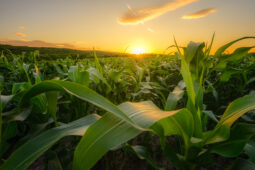Did you know that just one gram of soil can contain up to 10 billion organisms? On top of that only 1% of the microorganisms found in soil have been identified to date. Soil is a fascinating, living reservoir of microbial diversity – and more than 95% of the world’s food production relies on it.
In honor of World Soil Day, which takes place on December 5, three of our experts at BiOWiSH – Ronaldo Knychala, Senior Carbon Field Activities Manager, Alex Susko, PhD, Agronomy Product Manager, and Haley Nolen, PhD, Applied Scientist – shared their expert knowledge about soil testing for farming and research purposes.
Q: What is the purpose of soil testing for farmers?
Knychala: Soil testing aims to assess three main conditions of the soil: physical, chemical, and biological. This process gives farmers valuable insights such as soil nutrient levels, pH levels, organic matter percentage, density, and soil functionality in general. By understanding these elements, farmers are able to make smarter agronomy decisions for their farms. The results provide farmers and their advisors with the knowledge to enhance their soil ecosystem and to ensure their soil receives the right nutrients, at the right time and at the right rate for their intended yield goal. This helps reduce costs, minimize environmental impacts, improve soil health, and optimize yield results.
Q: How is it performed?
Knychala: Soil sampling is a simple task that requires soil sample collection typically at the depth of the root zone in multiple locations of the field. In addition, some farmers employ an additional deeper soil sample to measure nitrogen movement through the soil profile. With traditional sampling, soil cores are collected with soil probes from different areas of the field and mixed in a bucket to create a composite sample to be sent to a third-party lab to be analyzed. However, there are more detailed strategies including grid sampling and management zone strategies that can provide more comprehensive insight and a higher-level of accuracy. When deciding on what sampling method to use, it’s important for farmers to first evaluate their goals, environmental conditions, resources, and the return on investment.
Q: Where is the soil analyzed?
Susko: Once soil samples are collected, they must be sent to a third-party lab to be analyzed with specialized equipment. Soil testing labs, while long established in the United States, are now commonly found in major agricultural producing countries globally. Most soil testing facilities are either private labs or a university soil testing lab that offers it as a service. When selecting a lab, it’s important to understand the types of soil tests offered, costs, accuracy, turnaround time, and effectiveness of the fertility recommendations. Since farmers use the results to make financial and time-sensitive fertilizing decisions, it’s critical to receive quality data in a timely manner.
Q: When is the best time for soil testing?
Susko: It depends. Most farmers soil test after harvest to allow time for fertilizer purchase decisions. Fall testing can be also helpful in planning less soluble nutrients like phosphorus and potassium in the winter, which you can apply later in the fall. Many farmers also sample in early spring before planting so that they can have more accurate data to plan their nitrogen needs as well as other macronutrients and micronutrients.
Q: Is there a downside to not soil testing?
Susko: Soil is the foundation for plant growth. While some farmers don’t test and have success, an accurate sample provides farmers with precise data not only about soil nutrients, but also about the soil pH which is essential to nutrient availability and successful crop production. In addition, nitrogen levels can change quicker than other nutrients. If you don’t track your soil, you’re at risk of either under or over applying nutrients, which can lower yields or negatively impact profit.
Q: Why does BiOWiSH use soil testing?
Nolen: We soil test for product research including for the BiOWiSH® Fertilizer Enhancement. It allows us to gain precise data on what occurs in the soil during our field trials. We perform soil testing before we apply the fertilizer enhancement, in-season, and immediately post-harvest to analyze how our product impacts nutrient dynamics including nitrogen, phosphorus, potassium and secondary nutrients. We also test the physical characteristics of the soil, including the percentage of organic matter, which is a good reservoir of both nutrients and microbes. This enables us to accurately determine how our products are affecting nutrient concentrations in the soil and nutrient uptake to the crop.
Q: How does soil testing help BiOWiSH with product development?
Nolen: Soil testing is a vital research and development tool for BiOWiSH. It enables us to understand trends of how the BiOWiSH® Fertilizer Enhancement mode of action affects nutrient cycles in the soil. With our testing, we’ve corroborated results from more than 200 independent, replicated third-party research trials along with comparisons from hundreds of on-farm trials, to assess how product performance translates into real farming with varying growing conditions and geographical challenges. This meta-analysis approach enables us to identify trends and product performance across a wide array of locations and crops. In turn, we can help farmers produce more.
Learn More
Soil testing is a crucial resource for farmers to assess the health and productivity of their land. By examining the physical, chemical and biological conditions of the soil, growers can make well-informed decisions about crop management practices. Soil test results can also help pinpoint potential issues with soil health, enabling the creation of improvement plans to optimize crop yields and ensure long-term sustainability.
For more information on soil testing, refer to this fact sheet from the U.S. Department of Agriculture Natural Resources Conservation Services, or contact your local Extension office. To explore the benefits of BiOWiSH® Fertilizer Enhancement and review our research studies, visit https://www.biowishtechnologies.com/resources.





